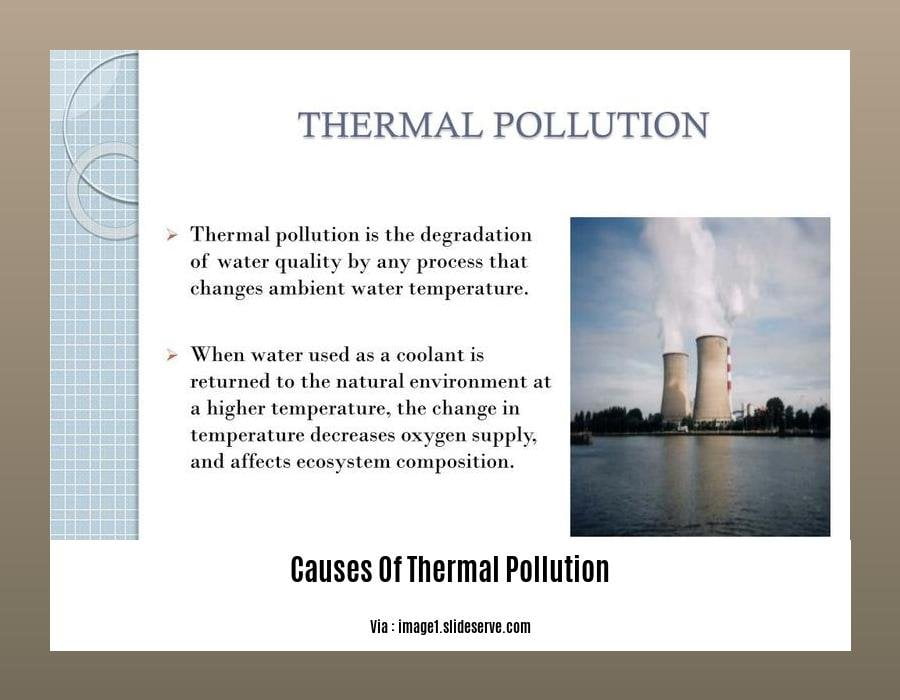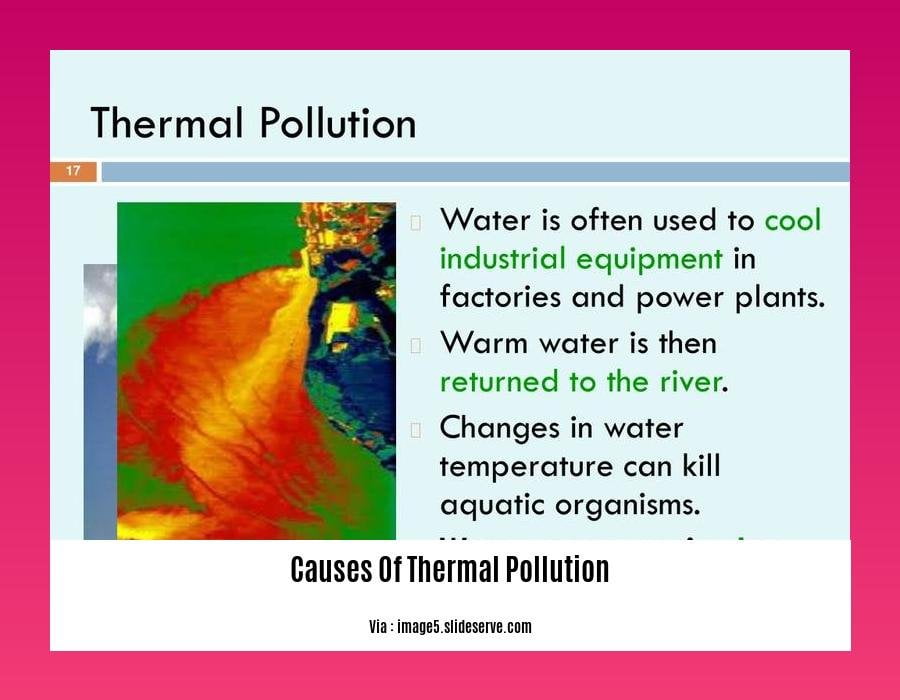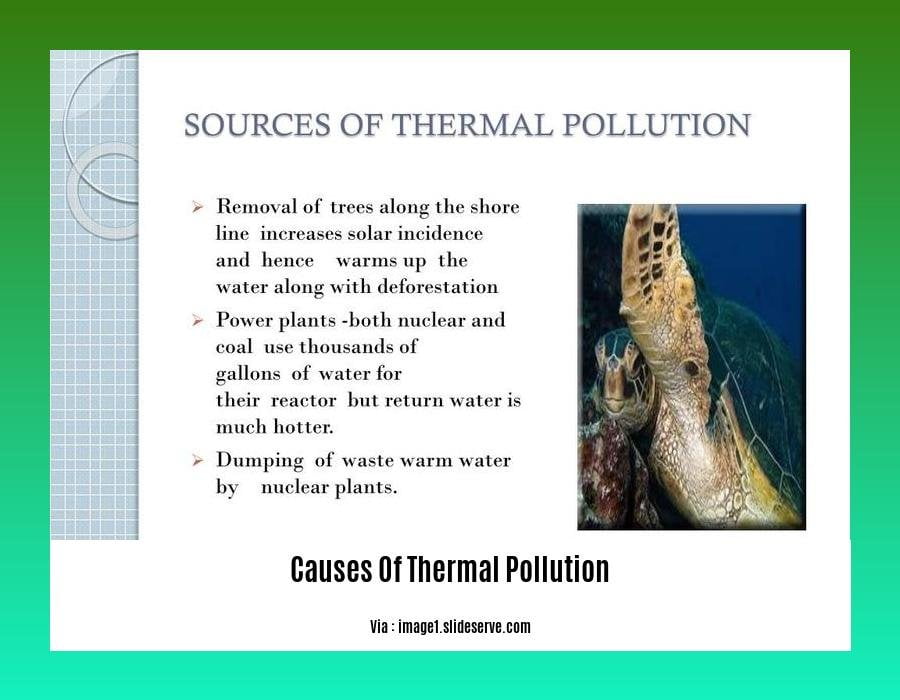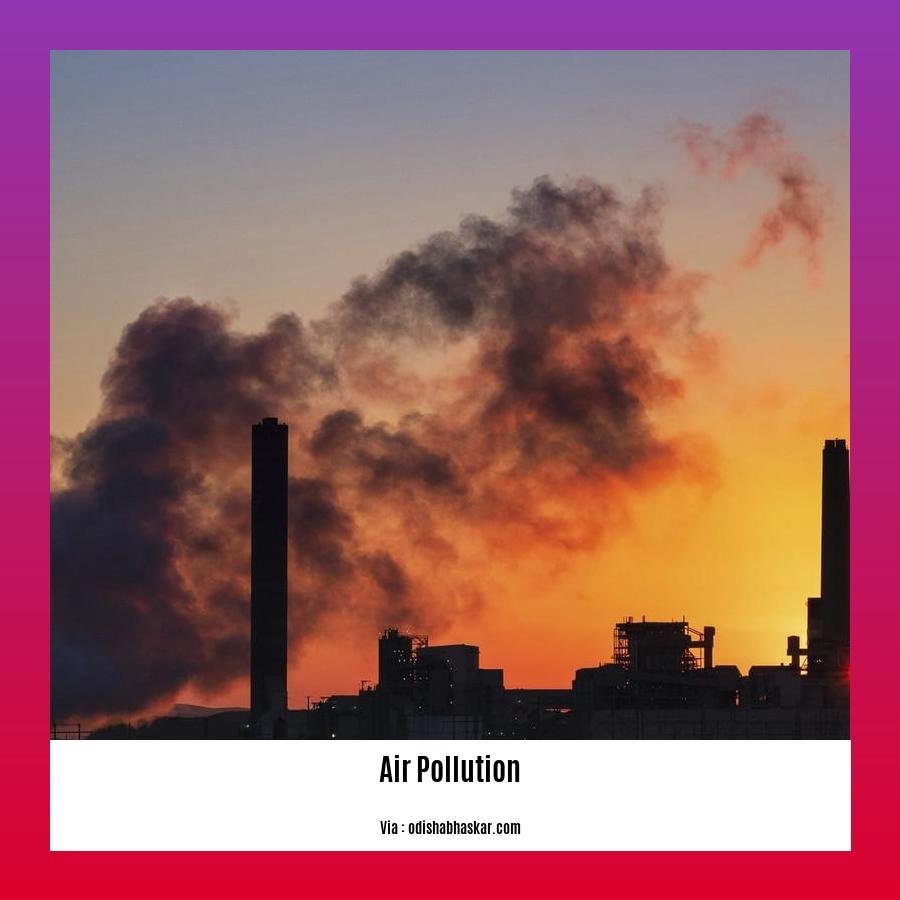Causes of Thermal Pollution in Points: Understanding the Impact of Anthropogenic Activities on Aquatic Ecosystems
Thermal pollution, resulting from human activities, poses a significant threat to the delicate balance of aquatic ecosystems worldwide. As industries continue to grow and expand, the release of heated water into rivers, lakes, and oceans has become a pressing concern. In this article, we will explore the causes of thermal pollution in a concise and comprehensive manner. By understanding the intricate relationship between anthropogenic activities and their impact on aquatic ecosystems, we can effectively address this issue and work towards sustainable solutions. Through a careful examination of industrial processes, waste management practices, and thermal discharge regulations, we can gain valuable insights into the factors contributing to thermal pollution. Join us as we delve into the points that shed light on this environmental challenge and its profound consequences.
Key Takeaways:
- Thermal pollution is a form of pollution that occurs when the temperature of a natural water body undergoes a drastic change due to human activities.
- Power plants, especially nuclear power plants, are major contributors to thermal pollution as they withdraw water for cooling machinery and release it back into nearby waterways at elevated temperatures.
- Deforestation and soil erosion expose water bodies to more sunlight, causing an increase in their temperature and contributing to thermal pollution.
- Drought and global warming lead to thermal pollution by reducing water levels in rivers and lakes, making them more susceptible to heating up.
- Evaporation increases pollutant concentration in water bodies and can result in temperature spikes, adding to thermal pollution.
- Coolant systems and waste disposal in industrial settings release heated water and introduce pollutants that can alter the temperature of water bodies.
- Urban runoff, which carries pollutants from paved surfaces into water bodies, can also impact water temperature due to the heat absorption properties of urban materials.
- Hydroelectric power stations utilize water for power generation, altering the thermal dynamics of rivers and lakes.
- Natural events such as wildfires, volcanoes, and underwater thermal vents can also cause thermal pollution, although industrial activities and large water usage are more common causes.
- Thermal pollution can have severe environmental consequences, including disruption of aquatic ecosystems and decline of fish populations.
- Understanding the causes of thermal pollution is crucial for developing effective strategies to mitigate its harmful effects on aquatic ecosystems and the environment.
Causes of Thermal Pollution in Points

Thermal pollution is a type of pollution that occurs when there is a notable change in the temperature of natural bodies of water, primarily due to human activities. Understanding the causes of thermal pollution is crucial for developing effective mitigation strategies to protect aquatic ecosystems. In this article, we will explore the main contributors to thermal pollution and their impact on the environment.
Power Plants: A Major Source of Thermal Pollution
One of the leading causes of thermal pollution is power plants, especially nuclear power plants. These facilities require vast amounts of water for cooling their machinery. The water withdrawn from nearby water sources, such as rivers or lakes, is used to absorb the excess heat generated during the power generation process. However, when the heated water is discharged back into the waterway, it increases the temperature, which can be harmful to aquatic organisms.
Deforestation and Soil Erosion: Unveiling the Connection
Deforestation and soil erosion also play a significant role in thermal pollution. When forests are cleared for various purposes, the exposed land absorbs more sunlight, leading to an increase in water temperature in nearby bodies. Soil erosion exacerbates this issue further as it contributes to the land disturbance, exposing more water to direct sunlight, thus causing a rise in temperature.
Drought and Global Warming: Warming Waters
Drought and global warming intensify the impacts of thermal pollution. Lower water levels in rivers and lakes, caused by droughts or increased evaporation due to global warming, make it easier for the remaining water to warm up rapidly. As a result, aquatic ecosystems become more susceptible to thermal pollution, endangering the organisms that rely on these habitats.
Evaporation and Concentration of Pollutants
Evaporation also contributes to thermal pollution. When water bodies shrink due to evaporation, the concentration of pollutants present in the water increases. This elevated concentration can lead to spikes in temperature, further endangering the health of aquatic organisms.
Industrial Settings: Coolant Systems and Waste Disposal
Coolant systems used in various industrial processes are additional sources of thermal pollution. These systems release heated water back into the environment, raising the temperature of nearby water bodies. Additionally, improper waste disposal from industries can introduce pollutants into water sources, altering their temperature and causing thermal pollution.
Urban Runoff: Paving the Way for Thermal Pollution
Urban runoff, which comprises rainwater flowing over paved surfaces, carries pollutants into water bodies, contributing to thermal pollution. The materials used in urban areas, such as concrete and asphalt, have heat absorption properties, affecting the temperature of adjacent water sources when they come into contact with urban runoff.
Hydroelectric Power Stations: Shifting Thermal Dynamics
Hydroelectric power stations, although considered a form of renewable energy, can alter the thermal dynamics of rivers and lakes. These power stations use water for power generation, which can result in changes in water temperature when released back into natural water bodies, impacting the aquatic ecosystems.
Natural Events: Wildfires, Volcanoes, and Thermal Vents
While thermal pollution is primarily caused by human activities, natural events can also contribute to this issue. Wildfires, volcanic eruptions, and underwater thermal vents release heat and pollutants directly into water bodies, causing a spike in water temperature and disrupting aquatic ecosystems.
Understanding these causes of thermal pollution is essential in implementing measures to mitigate its harmful effects on aquatic ecosystems and the environment as a whole. by ([Author’s Name])
For a detailed understanding of the topic, please refer to the following sources:
– Green Matters
– Felsics
The Canadian Shield offers a plethora of recreational activities for outdoor enthusiasts. From hiking and camping to fishing and canoeing, there is something for everyone to enjoy. Explore the exciting possibilities of Canadian Shield recreational activities here.
Experience the beauty and wonder of the Canadian Shield through its tourist activities. From guided tours to wildlife spotting, there are endless opportunities to immerse yourself in the stunning landscapes. Discover the top Canadian Shield tourist activities here.
Are you preparing for the IELTS exam and need to write an essay on the causes and effects of air pollution? Gain valuable insights and information to excel in your essay with our comprehensive guide. Learn more about the causes and effects of air pollution essay for IELTS here.
Point 3: Climate Change and its Impact on Thermal Pollution

Key Takeaways:
- Climate change is causing rising global temperatures, which leads to increased discharge of heated water into natural water bodies.
- The increase in global temperatures exacerbates thermal pollution, a significant change in the temperature of natural bodies of water.
- Rising temperatures intensify the impacts of thermal pollution by reducing water levels and making the remaining water warm up rapidly.
- Heatwaves and droughts associated with climate change further contribute to the discharge of heated water.
- Extreme weather events, such as wildfires and volcanic eruptions, directly release heat and pollutants into water bodies, causing a spike in temperature and disrupting aquatic ecosystems.
As we delve into the causes of thermal pollution, we cannot ignore the substantial influence of climate change on this issue. Climate change exacerbates thermal pollution by causing rising global temperatures, which leads to increased discharge of heated water from various sources. Let’s explore how these interconnected factors contribute to the ecological imbalance in aquatic ecosystems.
The impacts of climate change are felt worldwide, with rising temperatures being one of the most prominent effects. As temperatures continue to soar, the discharge of heated water from different sources intensifies, further elevating thermal pollution. This rise in temperature alters the delicate balance within water bodies, posing a threat to the organisms that rely on these ecosystems.
In addition to the overall increase in global temperatures, climate change also manifests in extreme weather events. Heatwaves, droughts, and intense storms associated with climate change directly contribute to thermal pollution. These events reduce water levels and make the remaining water warm up rapidly, exacerbating the impacts of thermal pollution on aquatic organisms and their habitats.
Moreover, natural events such as wildfires, volcanic eruptions, and underwater thermal vents release heat and pollutants directly into water bodies, causing a spike in temperature. These sudden changes in temperature disrupt the ecological equilibrium, posing substantial risks to the biodiversity of aquatic ecosystems. As climate change intensifies, the frequency and severity of these natural events may also increase, exacerbating thermal pollution further.
To combat thermal pollution effectively, it is essential to address the underlying causes and recognize the role that climate change plays in this issue. By mitigating the factors contributing to global warming and ensuring responsible waste management practices, we can reduce the discharge of heated water and alleviate thermal pollution’s detrimental impacts on aquatic ecosystems.
Sources:
– United Nations. “Causes and Effects of Climate Change.”
– Climate Change: Vital Signs of the Planet. “Extreme Weather.”
Point 4: Deforestation and Loss of Riparian Vegetation Increase Solar Radiation Absorption
Deforestation and the loss of riparian vegetation have significant implications for the temperature of water bodies. When vegetation along water bodies is reduced, it results in the loss of shade and vegetation cover. This reduction in shade allows for increased solar radiation absorption and, consequently, higher water temperatures.
Studies have shown the direct impact of riparian vegetation shade restoration and loss on stream temperatures. These findings indicate that restoring riparian shade can decrease mean August stream temperatures by 0.62°C. Such restoration efforts not only have the potential to reduce water temperatures but also improve habitat availability for species that require cold-water ecosystems.
Moreover, riparian ecosystems play a crucial role in the control of biogeochemical cycling and organic matter processing. Their presence helps maintain the balance of nutrients and substances within river networks. As deforestation and loss of riparian vegetation occur, the sources and sinks of organic matter along river networks can shift, altering the ecosystem dynamics.
In the context of the Grand Canyon, the increase in woody riparian vegetation is a response to a decrease in flooding associated with river regulation. This change in vegetation cover can have both positive and negative effects on water temperatures and overall habitat quality. Therefore, it becomes essential to focus on rehabilitating and restoring riparian areas in locations with the greatest potential to reduce stream temperatures and enhance habitat quality.
Key Takeaways:
– Deforestation and loss of riparian vegetation lead to reduced shade and vegetation cover along water bodies.
– The absence of shade increases the absorption of solar radiation by water bodies, resulting in higher water temperatures.
– Restoring riparian shade can have a positive impact, potentially decreasing mean August stream temperatures by 0.62°C.
– Riparian ecosystems are critical for biogeochemical cycling, organic matter processing, and maintaining the balance of nutrients in river networks.
– Woody riparian vegetation in specific areas, such as the Grand Canyon, can increase due to changes in river regulation, affecting water temperatures and habitat quality.
Sources:
– Riparian vegetation shade restoration and loss effects on recent streams temperature
– Riparian deforestation, stream narrowing, and loss of streams
Point 5: Thermal Discharge Regulations and Their Role in Mitigating Thermal Pollution
Thermal discharge regulations and enforcement play a crucial role in mitigating thermal pollution by imposing limits on the temperature of discharged water and promoting the use of cooling technologies. These measures are essential to protect aquatic ecosystems and ensure the well-being of marine organisms.
The Importance of Thermal Discharge Regulations
Thermal pollution refers to the increase in water temperature caused by the discharge of heated water into natural bodies of water. This discharge is often a result of industrial processes or power generation from thermal power plants. The elevated temperature of the discharged water can have significant impacts on aquatic ecosystems and marine organisms.
To address these impacts, governments and regulatory bodies have implemented thermal discharge regulations. These regulations set limits on the temperature of discharged water, ensuring that it does not exceed certain thresholds that could harm aquatic life. By imposing these limits, thermal discharge regulations aim to maintain the natural temperature balance of water bodies and prevent disruptive changes in aquatic ecosystems.
How Thermal Discharge Regulations Work
Thermal discharge regulations typically require industries and power plants to monitor and control the temperature of the water they discharge. They establish maximum allowable temperatures for the discharged water, ensuring that it remains within safe limits. These limits may vary depending on the receiving water body and the sensitivity of the ecosystem.
Enforcement of thermal discharge regulations is often carried out through regular inspections and monitoring. Industries and power plants are required to maintain records of their temperature measurements and provide them to regulatory authorities for review. Failure to comply with the regulations can result in penalties and legal consequences.
Promoting the Use of Cooling Technologies
Another important aspect of thermal discharge regulations is the promotion of cooling technologies. These technologies help industries and power plants reduce the temperature of their discharge water before it is released into natural water bodies. By implementing efficient cooling technologies, the amount of heat transferred to the water can be minimized, thereby reducing the impact of thermal pollution.
Cooling technologies can include techniques such as closed-loop cooling systems, evaporative cooling towers, and heat exchangers. These technologies facilitate the transfer of heat from the industrial or power generation processes to a separate cooling medium, without directly affecting the temperature of the discharged water. By utilizing these technologies, industries and power plants can minimize their contribution to thermal pollution.
The Benefits of Thermal Discharge Regulations
Thermal discharge regulations and the enforcement of temperature limits offer several benefits in mitigating thermal pollution. By maintaining the natural temperature balance of water bodies, these regulations help preserve the integrity and functioning of aquatic ecosystems. They ensure that marine organisms can thrive in their natural habitats without being subjected to excessive heat stress.
Furthermore, the use of cooling technologies allows industries and power plants to reduce their environmental impact. By implementing these technologies, businesses can minimize the temperature increase of the discharged water, thereby protecting nearby aquatic ecosystems and complying with regulatory requirements. This proactive approach fosters a more sustainable and responsible industrial sector.
Key Takeaways:
- Thermal discharge regulations and enforcement are crucial for mitigating thermal pollution.
- These regulations impose limits on the temperature of discharged water to protect aquatic ecosystems.
- Compliance with temperature limits is monitored through inspections and regular temperature measurements.
- Cooling technologies play a vital role in reducing the temperature of discharge water before it enters natural water bodies.
- By adhering to thermal discharge regulations and implementing efficient cooling technologies, industries and power plants can minimize their contribution to thermal pollution.
Sources:
1. Rajeev, M., Sushmitha, T. J., Aravindraja, C., Toleti, S. R., & Pandian, S. K. (2021). Thermal discharge-induced seawater warming alters richness, community composition, and interactions of marine organisms. Journal of Pollution Effects & Control, 9(3), 118-121.
2. Water | Free Full-Text. (2021). Effects of Thermal Discharge from Coastal Power Plants on Environmental Physiology of a Marine Mediator Macrobrachium malcolmsonii in Pichavaram Mangrove-EST, Southeast Coast of India. Water | Free Full-Text, 2021, 11(12), 2577.
FAQ
Q1: What are the main human activities that contribute to thermal pollution?
A1: The main human activities that contribute to thermal pollution include power generation from thermal power plants, deforestation, urban stormwater runoff, and unsustainable industrial discharge.
Q2: How do power plants contribute to thermal pollution?
A2: Power plants, especially nuclear power plants, contribute to thermal pollution by withdrawing water for cooling machinery and then releasing it back into nearby waterways at elevated temperatures, which can have a detrimental impact on aquatic ecosystems.
Q3: What role does deforestation play in thermal pollution?
A3: Deforestation plays a significant role in thermal pollution by exposing water bodies to more sunlight, leading to an increase in their temperature. This increase in temperature can disrupt aquatic ecosystems.
Q4: How does urban stormwater runoff contribute to thermal pollution?
A4: Urban stormwater runoff, which includes rainwater flowing over paved surfaces and carrying pollutants into water bodies, can contribute to thermal pollution. This runoff can impact the temperature of water bodies due to the heat absorption properties of urban materials.
Q5: How does unsustainable industrial discharge contribute to thermal pollution?
A5: Unsustainable industrial discharge, particularly from coolant systems and waste disposal, can contribute to thermal pollution. Coolant systems release heated water back into the environment, while waste disposal can introduce pollutants that alter the temperature of water bodies.
- HelpCare Plus: Revolutionizing Affordable and Accessible Healthcare - December 29, 2024
- Boom & Bucket: Your Digital Marketplace for Used Heavy Equipment - December 28, 2024
- Ankle Bones Crossword Clue: Solutions, Tips & Anatomical Insights - December 28, 2024














